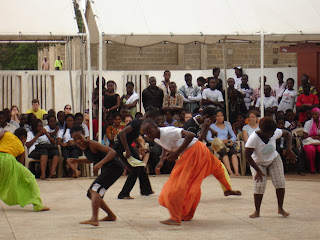

On November 4, 2008, history was made when Barack Obama was elected the 44th President of the United States of America. It was truly a blessings to have voted from West Africa and been in Ghana to witness the enthusiasm and pride that Ghanaians expressed. Africans see Obama not only as an American, but an African too, and they celebrate his victory as a victory for black people worldwide. Kenya declared November 5 a national holiday.
I could not let the day go by without organizing something in the Department of Dance Studies here at the Unviersity of Ghana-Legon. The first photo is of Professor Oh! Nii Sowah, Head of the Department of Dance Studies and myself celebrating at the School of Performing Arts. The following are some photos that were taken of our celebration for Barack Obama with students, staff & faculty: we did the Electric Slide, and the Ghanaian Kpanlogo dance, all while chanting: “Barack Obama is President! Yes We Can! Yes We Can!

Students Celebrating with Signs reading Yes We Can!

Give the Drummers Some! The Heartbeat of the Celebration

Oh! Nii Sowah, Head of the Department of Dance Studies, & Halifu Get Down for Obama

Body & Soul - In the Spirit

Oh! Nii, Nii Yartey, & Halifu, with Terry Ofosu in back, Glorifying the Celebration

YES WE CAN!
THEN I THOUGHT OF OBAMA'S ACCEPTANCE SPEEECH WHEN HE SPOKE OF MRS. ANN COOPER, THE 106 YEAR OLD, WHO VOTED FOR HIM IN ATLANTA:

"This election had many firsts and many stories that will be told for generations. But one that's on my mind tonight is about a woman who cast her ballot in Atlanta. She's a lot like the millions of others who stood in line to make their voice heard in this election except for one thing - Ann Nixon Cooper is 106 years old. She was born just a generation past slavery; a time when there were no cars on the road or planes in the sky; when someone like her couldn't vote for two reasons - because she was a woman and because of the color of her skin." Barack Obama, November 4, 2008
AND I WAS MOVED, AND REMEMBERED WHAT I HAD WRITTEN WHEN I WOKE UP IN GHANA ON NOVEMBER 4TH:
TODAY IS THE DAY
November 4, 2008 will go down in history. It is the day a black man will become President of the most powerful nation in the world---the United States of America. Barack Obama is destined to begin to vindicate the 400 years of the degradation of people of African descent worldwide. For it is not just African Americans (Blacks, Negroes, Coloreds, Negras) whose history will begin to be atone for, but it is the entire Black “Race.” People here in Ghana are poised to celebrate just like in the U.S. It is clear that the Creator has chosen him as The One, he who is to break the barrier of slavery, segregation, colonialism, Him-Crowism, the lynchings, the vicious violence and discrimination, the psychological cultural racism, the deliberate stripping of culture (that failed), and the basic human suffering that lodged in every individual soul, each family, each community and village, each region (South, North, East, & West), each nation (especially the US), and indeed the world.
Barack Obama’s election as President of the U.S. is much more than a personal story. It is an vindication of a people whose story has become the quintessential narrative of oppression (rivaling the Jews). Obama carries a lot on his shoulders; but he is The One, the one who has been chosen to do so. And as the world watches in anticipation, our Ancestors hover in the Wind, the Rivers, the Oceans---Waiting!




































